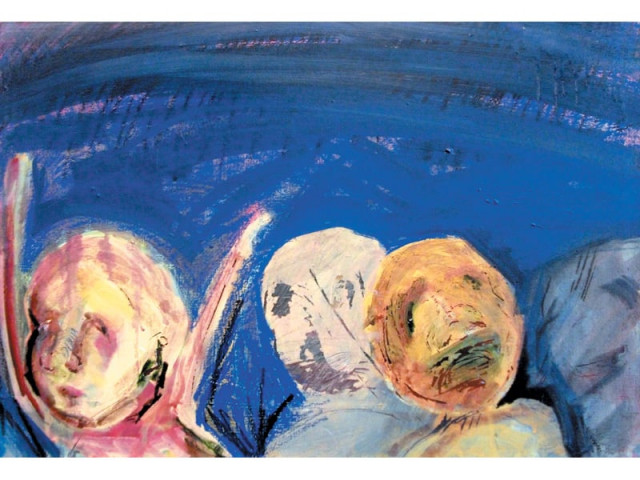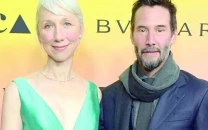New art at Indus
The subject of dying, specifically a burial, marks three large canvases by young Indus Valley artist, Fariha Hassaan.

“Life is sweet, Jasper. There’s day and night, Jasper, both sweet things. There’s sun, moon and stars, brother, all sweet things, there’s likewise a wind on the heath. Who would wish to die…?”
At the start of WWII, the preeminent New Zealand writer Janet Frame reads from a book by George Borrow. In the novel, a discussion ensues between two protagonists regarding the value of life. For the sensitive Frame, who undergoes excruciating years in a mental asylum, with a falsely diagnosed illness, this passage reads like quiet and marvelous poetry. “[But] who would wish to die?”
The subject of dying, specifically a burial, marks three large canvases by young Indus Valley artist, Fariha Hassaan. Part of the small, fine art thesis show, Hassaan’s work stands out for its striking use of colour and for its vibrant free-form execution. Both aspects seem to belie the convention at hand. And one is compelled to ask, “Where exactly is the painting?”
Rendered in oils, a shrouded figure rests in a casket in the foreground of the work. A group of onlookers, spontaneously drawn, stand to one side, almost grasping at the stained cloth. One glimpses a garden, bright flowers and green, as the setting for this scene of mourning. Further in, through flat swathes of blues, shot pinks, in the upper right-hand region, we discern an old silhouette. A picnic is ongoing.
This image is hard to view, for any extended time. It is transformed from its original clarity, in swift overlays of colour, and in rapid pastel strokes. The latter give to the painting as a whole, a tremulous, tentative, desecrating energy — something childlike even, juvenilia, hard to view.
We turn to speak of anger. We speak in fact of aesthetics. With readerly eloquence, Hassaan describes her art-making process as a movement away from description, towards a more gestural style. In this, she cites artists Cy Twombly and Dana Schutz as imminent influences.
This particular canvas grew from a personal reference, an intimate death in the family. She remaindered it for several months and worked on several smaller pieces in the mean. Upon returning to the main work five months later, she found it entirely closed to her. Surface marks then served as a way for the artist to re-enter the image and, in turn, return it to life. Anger, agitation, in its release and as an aspect of grief, is sieved here in brilliant colour. The painting may be “found” in its gestures, the young artist reiterates.
As a first body of work, Hassaan’s paintings possess a distinct persona, aesthetic flare and sense of ambition. Resonant as it is itself in other canvases, “X’s Funeral Part” may be considered striking for its range of sensation, and for its cumulative ambivalence. Set another way, one may surmise that despite graphic exclamation, this is the work of a very private artist.
Looking at it, a legion of expressionist painters come to mind, both locally (particularly in the 80s), and internationally, who were concerned with the polemics of subject-formation on canvas. Such work entails rich, often dangerous emotional quarrying; and it invokes a disruption of the world as it exists, in the structure of the self.
Expressive colour, a sense of vibrancy and free rhythm, strong brushwork are oft deployed to convey a sense of human experience, not yet voiced or otherwise excluded from mainstream discourse. This is not painting for the sake of catharsis or catharsis alone. With rigour, such art generates vital creative energy, counterpoised to systems of psychic and physical erasure.
As with Hassaan’s canvases, one may return to Frame’s sentimental reference, her urge to render a feel for existence. For “who would wish to die…?”
Published in The Express Tribune, December 10th, 2011.



















COMMENTS
Comments are moderated and generally will be posted if they are on-topic and not abusive.
For more information, please see our Comments FAQ